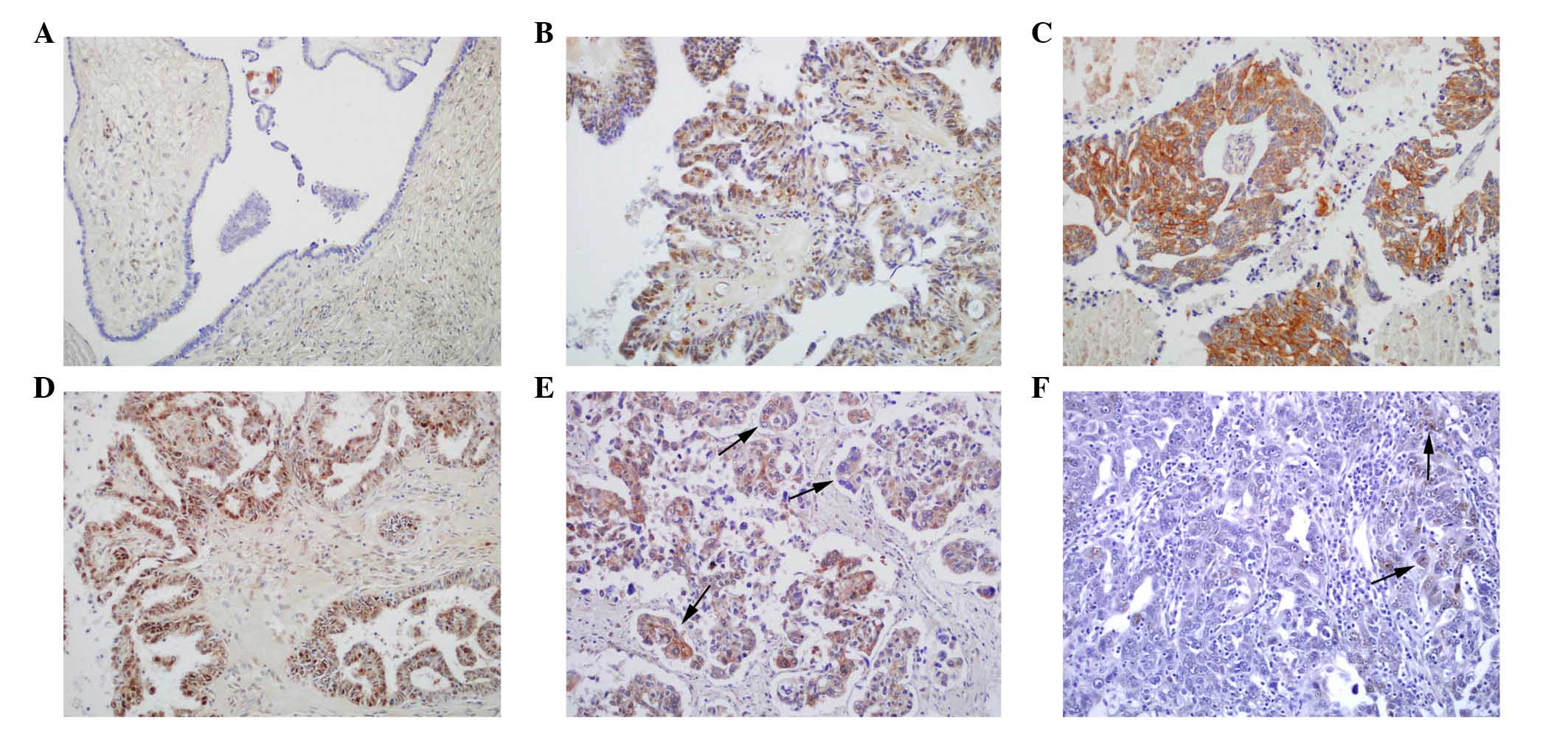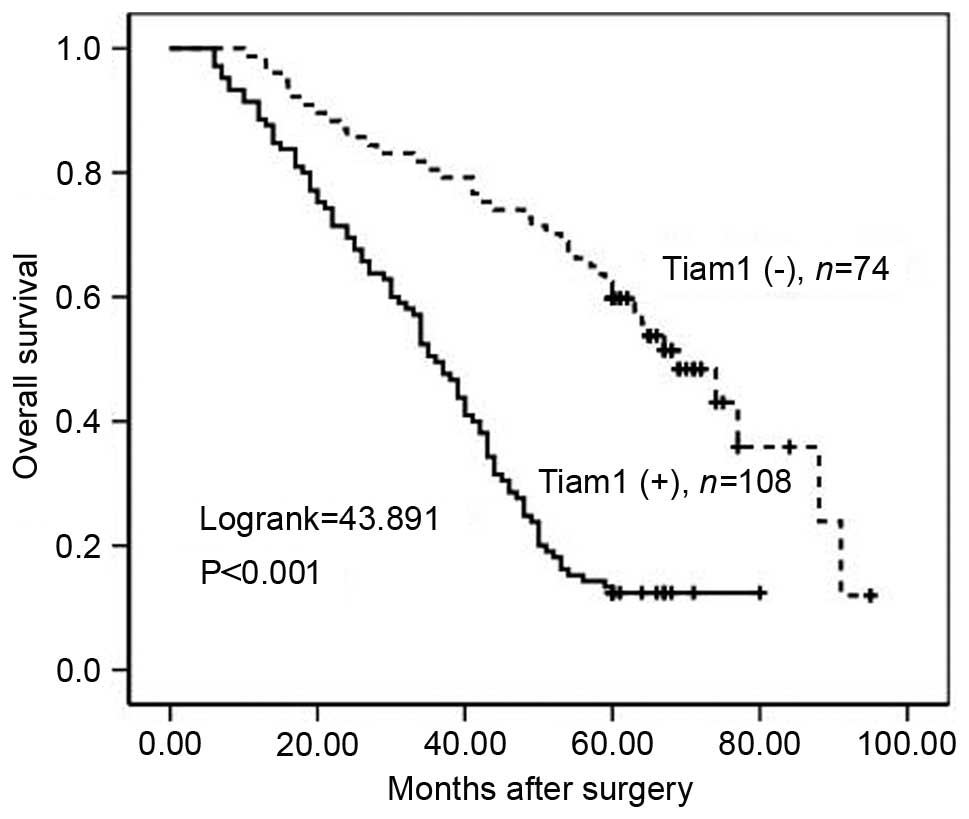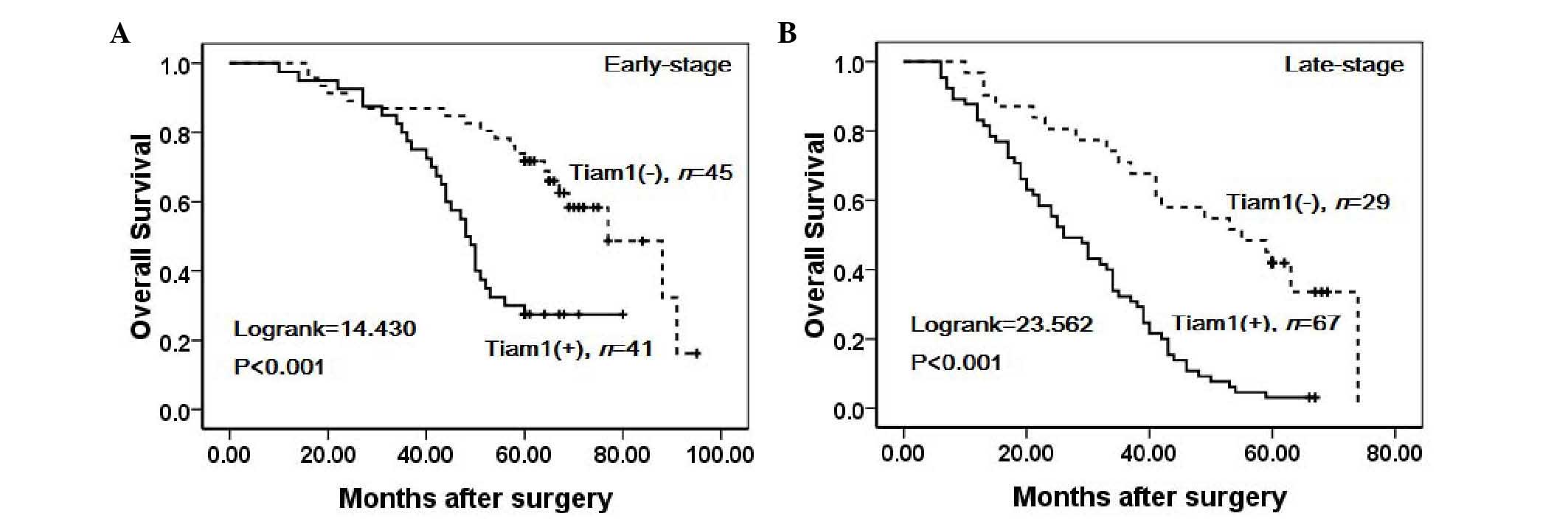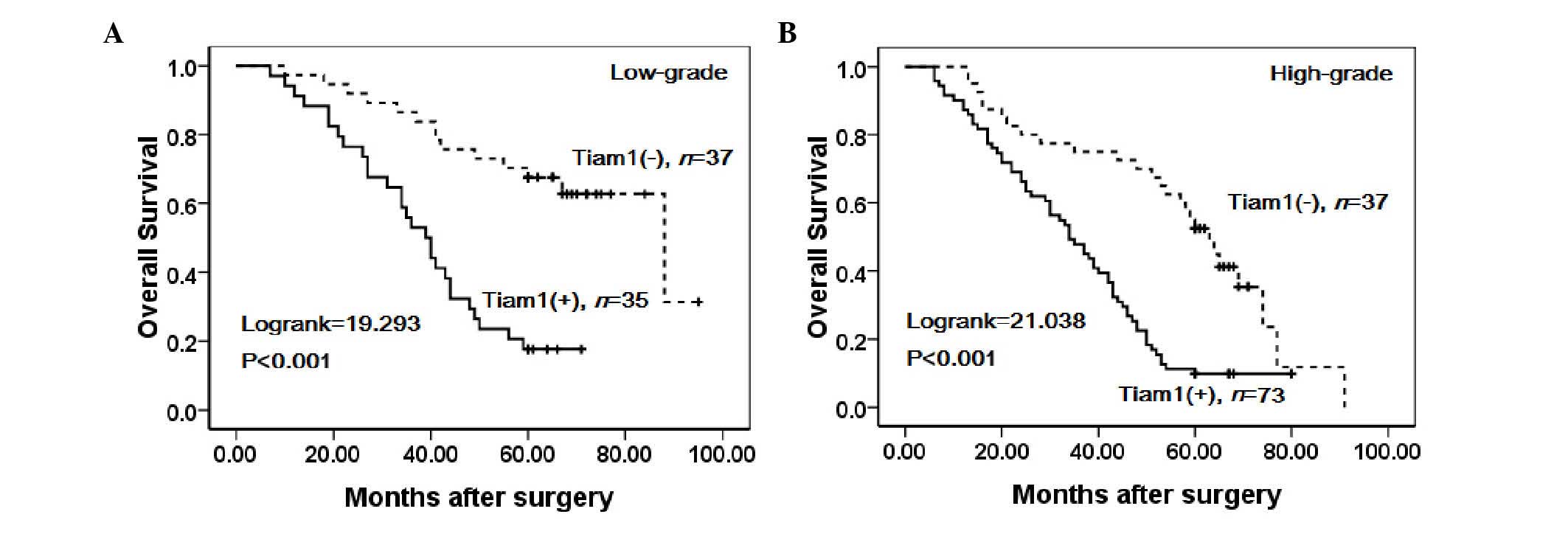|
1
|
Siegel R, Ma J, Zou Z and Jemal A: Cancer
statistics, 2014. CA Cancer J Clin. 64:9–29. 2014. View Article : Google Scholar : PubMed/NCBI
|
|
2
|
Smolle E, Taucher V, Pichler M, Petru E,
Lax S and Haybaeck J: Targeting signaling pathways in epithelial
ovarian cancer. Int J Mol Sci. 14:9536–9555. 2013. View Article : Google Scholar : PubMed/NCBI
|
|
3
|
Habets GG, Scholtes EH, Zuydgeest D, van
der Kammen RA, Stam JC, Berns A and Collard JG: Identification of
an invasion-inducing gene, Tiam-1, that encodes a protein with
homology to GDP-GTP exchangers for Rho-like proteins. Cell.
77:537–549. 1994. View Article : Google Scholar : PubMed/NCBI
|
|
4
|
Habets GG, van der Kammen RA, Stam JC,
Michiels F and Collard JG: Sequence of the human invasion-inducing
TIAM1 gene, its conservation in evolution and its expression in
tumor cell lines of different tissue origin. Oncogene.
10:1371–1376. 1995.PubMed/NCBI
|
|
5
|
Hordijk PL, ten Klooster JP, van der
Kammen RA, Michiels F, Oomen LC and Collard JG: Inhibition of
invasion of epithelial cells by Tiam1-Rac signaling. Science.
278:1464–1466. 1997. View Article : Google Scholar : PubMed/NCBI
|
|
6
|
Michiels F, Habets GG, Stam JC, van der
Kammen RA and Collard JG: A role for Rac in Tiam1-induced membrane
ruffling and invasion. Nature. 375:338–340. 1995. View Article : Google Scholar : PubMed/NCBI
|
|
7
|
Mertens AE, Roovers RC and Collard JG:
Regulation of Tiam1-Rac signalling. FEBS Lett. 546:11–16. 2003.
View Article : Google Scholar : PubMed/NCBI
|
|
8
|
Bollag G, Crompton AM, Peverly-Mitchell D,
Habets GG and Symons M: Activation of Rac1 by human Tiam1. Methods
Enzymol. 325:51–61. 2000. View Article : Google Scholar : PubMed/NCBI
|
|
9
|
Matsuo N, Terao M, Nabeshima Y and Hoshino
M: Roles of STEF/Tiam1, guanine nucleotide exchange factors for
Rac1, in regulation of growthcone morphology. Mol Cell Neurosci.
24:69–81. 2003. View Article : Google Scholar : PubMed/NCBI
|
|
10
|
Du X, Wang S, Lu J, Wang Q, Song N, Yang
T, Dong R, Zang L, Yang Y, Wu T and Wang C: Clinical value of
Tiam1-Rac1 signaling in primary gallbladder carcinoma. Med Oncol.
29:1873–1878. 2012. View Article : Google Scholar : PubMed/NCBI
|
|
11
|
Qi Y, Huang B, Yu L, Wang Q, Lan G and
Zhang Q: Prognostic value of Tiam1 and Rac1 overexpression in
nasopharyngeal carcinoma. ORLJ Otorhinolaryngol Relat Spec.
71:163–171. 2009. View Article : Google Scholar
|
|
12
|
Xu K, Rajagopal S, Klebba I, Dong S, Ji Y,
Liu J, Kuperwasser C, Garlick JA, Naber SP and Buchsbaum RJ: The
role of fibroblast Tiam1 in tumor cell invasion and metastasis.
Oncogene. 29:6533–6542. 2010. View Article : Google Scholar : PubMed/NCBI
|
|
13
|
Malliri A, van der Kammen RA, Clark K, van
der Valk M, Michiels F and Collard JG: Mice deficient in the Rac
activator Tiam1 are resistant to Ras-induced skin tumours. Nature.
417:867–871. 2002. View Article : Google Scholar : PubMed/NCBI
|
|
14
|
Adam L, Vadlamudi RK, McCrea P and Kumar
R: Tiam1 overexpression potentiates heregulin-induced lymphoid
enhancer factor-1/beta-catenin nuclear signaling in breast cancer
cells by modulating the intercellular stability. J Biol Chem.
276:28443–28450. 2001. View Article : Google Scholar : PubMed/NCBI
|
|
15
|
Minard ME, Ellis LM and Gallick GE: Tiam1
regulates cell adhesion, migration and apoptosis in colon tumor
cells. Clin Exp Metastasis. 23:301–313. 2006. View Article : Google Scholar : PubMed/NCBI
|
|
16
|
Engers R, Mueller M, Walter A, Collard JG,
Willers R and Gabbert HE: Prognostic relevance of Tiam1 protein
expression in prostate carcinomas. Br J Cancer. 95:1081–1086. 2006.
View Article : Google Scholar : PubMed/NCBI
|
|
17
|
Huang J, Ye X, Guan J, Chen B, Li Q, Zheng
X, Liu L, Wang S, Ding Y, Ding Y and Chen L: Tiam1 is associated
with hepatocellular carcinoma metastasis. Int J Cancer. 132:90–100.
2013. View Article : Google Scholar : PubMed/NCBI
|
|
18
|
Liu H, Shi G, Liu X, Wu H, Fan Q and Wang
X: Overexpression of Tiam1 predicts poor prognosis in patients with
esophageal squamous cell carcinoma. Oncol Rep. 25:841–848.
2011.PubMed/NCBI
|
|
19
|
Wang H, Wang H, Makki MS, Wen J, Dai Y,
Shi Q, Liu Q, Zhou X and Wang J: Overexpression of β-catenin and
cyclinD1 predicts a poor prognosis in ovarian serous carcinomas.
Int J Clin Exp Pathol. 7:264–271. 2013.PubMed/NCBI
|
|
20
|
Cui X, Li L, Yan G, Meng K, Lin Z, Nan Y,
Jin G and Li C: High expression of NQO1 is associated with poor
prognosis in serous ovarian carcinoma. BMC Cancer. 15:2442015.
View Article : Google Scholar : PubMed/NCBI
|
|
21
|
Ma Y, Kong J, Yan G, Ren X, Jin D, Jin T,
Lin L and Lin Z: NQO1 overexpression is associated with poor
prognosis in squamous cell carcinoma of the uterine cervix. BMC
Cancer. 14:4142014. View Article : Google Scholar : PubMed/NCBI
|
|
22
|
Liu S, Li Y, Qi W, Zhao Y, Huang A, Sheng
W, Lei B, Lin P, Zhu H, Li W and Shen H: Expression of Tiam1
predicts lymph node metastasis and poor survival of lung
adenocarcinoma patients. Diagn Pathol. 9:692014. View Article : Google Scholar : PubMed/NCBI
|
|
23
|
Sander EE, van Delft S, ten Klooster JP,
Reid T, van der Kammen RA, Michiels F and Collard JG:
Matrix-dependent Tiam1/Rac signaling in epithelial cells promotes
either cell-cell adhesion or cell migration and is regulated by
phosphatidylinositol 3-kinase. J Cell Biol. 143:1385–1398. 1998.
View Article : Google Scholar : PubMed/NCBI
|
|
24
|
Sander EE, ten Klooster JP, van Delft S,
van der Kammen RA and Collard JG: Rac downregulates Rho activity:
Reciprocal balance between both GTPases determines cellular
morphology and migratory behavior. J Cell Biol. 147:1009–1022.
1999. View Article : Google Scholar : PubMed/NCBI
|
|
25
|
Boissier P and Huynh-Do U: The guanine
nucleotide exchange factor Tiam1: A Janus-faced molecule in
cellular signaling. Cell Signal. 26:483–491. 2014. View Article : Google Scholar : PubMed/NCBI
|
|
26
|
Yu LN, Zhang QL, Li X, Hua X, Cui YM,
Zhang NJ, Liao WT and Ding YQ: Tiam1 transgenic mice display
increased tumor invasive and metastatic potential of colorectal
cancer after 1,2-dimethylhydrazine treatment. PLoS One.
8:e730772013. View Article : Google Scholar : PubMed/NCBI
|
|
27
|
Li J, Liang S, Jin H, Xu C, Ma D and Lu X:
Tiam1, negatively regulated by miR-22, miR-183 and miR-31, is
involved in migration, invasion and viability of ovarian cancer
cells. Oncol Rep. 27:1835–1842. 2012.PubMed/NCBI
|
|
28
|
Kurman RJ and le M Shih: Pathogenesis of
ovarian cancer: Lessons from morphology and molecular biology and
their clinical implications. Int J Gynecol Pathol. 27:151–160.
2008.PubMed/NCBI
|
|
29
|
Yang W, Lv S, Liu X, Liu H, Yang W and Hu
F: Up-regulation of Tiam1 and Rac1 correlates with poor prognosis
in hepatocellular carcinoma. Jpn J Clin Oncol. 40:1053–1059. 2010.
View Article : Google Scholar : PubMed/NCBI
|





















